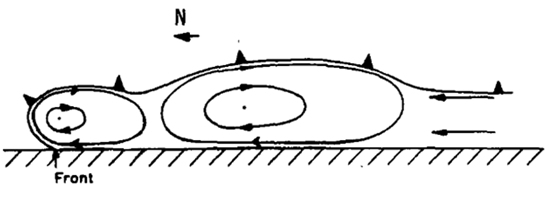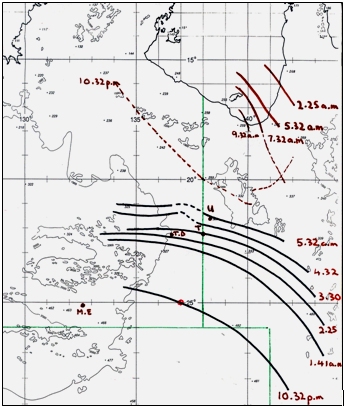Meteorological Physical Background
The interaction of a Southern Ocean cold front or oceanic trough or coastal low with the Australian continent is the important process for the generation and maintenance of Australian shallow cold fronts. The enhancement of strong temperature contrasts between land and ocean during summer generates Type 2 fronts, the interaction of the cold front with the Great Dividing Range generates the Southerly Buster. Nocturnal boundary layer processes over the arid Australian interior maintain the Central Australian front.

|
|
Figure 11: Summary of the Type 2 front, the Southerly Buster and the Central Australian front.
|
Summary of the Type 2 front, the Southerly Buster and the Central Australian front. Progression of the fronts is annotated as a-b. Also shown are Southern Ocean low pressure centres (L), solitary wave trains that propagate ahead of a Southern Ocean front (S) and Southern Morning Glories travelling ahead of a Central Australian front (MG). Australian states are Victoria (VIC), New South Wales (NSW), Queensland (QLD), South Australia (SA), Western Australia (WA), Northern Territory (NT) and Tasmania (T). The Great Dividing Range (G) is also shown.
Broad Overview
Type 2 summer cold front
A schematic showing the mechanism of genesis of Type 2 fronts ahead of an approaching Southern Ocean front is shown below. This may involve an interaction between the front and the summertime heat trough located over continental Australia. The temperature contrasts between the cool ocean and the hot continent is enhanced by the low level wind field within the deformation zone of the heat trough. This mesoscale frontogenesis is particularly pronounced along and inland of the east coast of South Australia and Victoria where the coastline is near parallel to the approaching front. It has also been observed inland of southwestern parts of the continent (Western Australia).
This frontogenesis generates the Type 2 front with a weakening of the Southern Ocean front upstream. This can result in an apparent "jump" in the progression of the change, with the front typically traversing coastal regions between late morning and early evening.
|
Figure 12: Development of the Type 2 fronts. LHS during the day, RHS front replacement during the evening.
|
The lifecycle of four Type 2 cold fronts are shown below. In all cases genesis occurs inland from the east coast of South Australia and Victoria. Eastward propagation is more rapid over the maritime region so the front deforms in shape. The fronts shown here dissipated over inland Victoria / southern New South Wales, though on occasions this system may interact with the mountains of the Great Dividing Range and evolve into a Southerly Buster.
|
Figure 13: Isochrones of four 'Type 2' cold fronts crossing southern Victoria and Bass Strait. (a) 8 February 1983, (b) 16 February 1983, (c) 14 January 1985, (d) March 1986. Images from Garratt 1988
|
As these fronts typically occur during the latter part of summer there is generally little atmospheric moisture available so only shallow cloud may define the front. The fronts have similarities to an unsteady shallow gravity current. A very strong cold front with the structure of a gravity current is shown below. Note the relative flow of cold air towards the leading edge and strong ascent at the head of the front.

|
|
Figure 14: Schematic of a Type 2 summertime front. Very shallow surface cold air flows towards the leading edge (blue arrows). Circulation at the head of the current is shown with entrainment of pre-frontal air (green arrows). Image from Tepper 1950
|
"Southerly Buster"
A Southerly Buster is the result of a cold front which interacts with topography, specifically the Great Dividing Range of southeastern Australia. This results in the channelling of the cool maritime air around the southeastern part of the mountain ranges and the blocking of the flow on the western side of the mountains. The upslope flow on the southern and eastern flank of the ranges induces anticyclonic turning of the winds resulting in a ridge of high pressure behind the cold front. A schematic of a Southerly Buster on the synoptic and mesoscale is shown below.

|
|
Figure 15: Schematic of the Southerly Buster on the synoptic and mesoscale. Upslope flow resulting in anticyclonicity and strengthening of the ridge of high pressure (U).
|
Many of the fronts classified as "Southerly Busters" are not southern ocean fronts but had formed on the pre-frontal trough south of the continent or appeared to originate on the southern NSW coast in association with shallow mesoscale low development. The lifespan of the Buster is generally less than 24 hours from the time the cold front reaches the Great Dividing Range in southern NSW to its dissipation on the north coast or southern coast of Queensland.
As the Southerly Buster progresses northwards the strength and depth of the surge decreases, however in some cases the Buster strengthens north of the Hunter valley. This is due to upslope flow north of the valley permitting the flow to acquire anticyclonic vorticity in a manner similar to the original blocking and formation of the Southerly Buster in Victoria.

|
|
Figure 16: Isochrones showing the progression of the Southerly Buster from 06EDST 25 November 1982 to 01 EDST 26 November 1982.Image from Colquhoun et al. 1985
|
The Buster advances into a strongly stable boundary layer with warm summertime prefrontal continental air advecting over a cooler sea. This may results in a roll vortex which extends ahead of the cold front in about half of the observed Busters. The gravity current head breaks away from the feeder flow supplying it with cold air as shown in the diagram below. In this way the Buster does not behave like a gravity current. The pre-frontal boundary layer is between 100 and 200 metres deep and if the pre-frontal stable layer is deep and strong, the roll vortex will evolve as a solitary wave type disturbance or as a bore wave that propagates on the stable layer.

|
|
Figure 17: The Southerly Buster frontal structure in cross section
|
The Southerly Buster frontal structure in cross section parallel to the coast for the event of the 11th December 1972. Streamlines represent airflow relative to the circulation centres of the roll vortices and straight arrows indicate wind direction. The first circulation cell corresponds with the 28 minute period following the first wind change and the second cell with the subsequent two hour period.
Central Australian Fronts
During the colder months cold fronts often penetrate across the Australian continent, sometimes reaching the northern shores of the continent at the Gulf of Carpentaria. These fronts are generally no deeper than about 1km and they advance into a convectively well mixed boundary layer, typically 3-4 km deep that overlies a strong shallow radiation inversion during the night.
Central Australian fronts are strongly modulated by the diurnal cycle with frontogenesis confined to the boundary layer, indeed. In particular the fronts weaken and decelerate after sunrise and strengthen and accelerate in the evening.
During the day two processes result in frontolysis. Firstly, radiative heating and associated turbulent mixing act to decelerate the low level winds which results in a reduction in the deformation and convergence. Secondly the air in contact with the heated surface is rapidly mixed through the boundary layer which is inversely proportional to the depth of the layer. Hence the shallow cold side of the front warms faster than the deep and well mixed boundary layer on the warm side of the front resulting in a decrease in the temperature contrast across the front.
After sunset the front redevelops rapidly and accelerates once the boundary layer turbulence moderates. Decoupling between the atmosphere and the surface occurs with the reduced low level friction. This causes the ageostrophic wind vector to rotate anticlockwise (in the Southern Hemisphere) due to the removal of friction and the resultant unbalanced Coriolis force. This inertial oscillation results in supergeostrophic winds and as these low level winds strengthen so do the contributions made to frontogenesis by deformation and convergence, as shown in the figure below.

|
|
Figure 17: Schematic showing the diurnal modulation.
|
Schematic showing the diurnal modulation in the strength of the Central Australian front. The geostrophic wind vector (Vg) is shown as well as the development of supergeostrophic cross-isobar flow due to the anticlockwise rotation of the ageostrophic wind vector (Va).
In the early stages, whilst the front is over South Australia, there is normally an inland heat trough over northeastern Queensland. As the front progresses eastwards the frontal trough and heat trough merge.
As the front strengthens and encounters the developing radiation inversion and cool air advected inland by the sea breeze from the Gulf of Carpentaria to the north, "Southern Morning Glories" are observed to develop during the early hours of morning. These propagates upon the radiation and/or sea-breeze inversion ahead of the air-mass change and develop a series of large-amplitude waves at the leading edge as shown in the right hand panel in the diagram below.

|
|
Figure 18: Central Australian front during day (left) and during night (right). Also showing the development of a "Southern Morning Glory" on pre-frontal inversion.
|
Of the 15 fronts observed during the field experiments starting in 1988 and extending over 10 years, 13 crossed central Australia during the evening or early hours of the morning. These fronts normally cross the continent from south to north within a day or two

|
|
Figure 19: Isochrones showing the progression of the Central Australian front of 11 September 1996. Image from Deslandes 2002
|
Geographical Location
The figure below the climatology of cold fronts divided into three-monthly subsets. The frequency of cold fronts in the region is largest in summer with pronounced local maxima over southwestern and southeastern Australia. These maxima are distinct from the maxima to the south of the continent over the Southern Ocean. This indicates frontolysis of Southern Ocean fronts as these approach the Australian continent, with regeneration over the continent as predominantly Type 2 summertime shallow cold fronts. The distribution of central Australian fronts can be seen in the climatology for the spring months of September, October and November. Southerly Busters occur predominantly along the southeast coasts of the continent, specifically the east coasts of Victoria and New South Wales. It is possible that these Busters also affect the east coast of the island of Tasmania to the south of the Australian continent, as the orientation of the coast and the topography has similarities to the aforementioned coastline.
|
Figure 20: Mean seasonal evolution of cold front frequency for March to May (MAM), June to August (JJA), September to November (SON) and December to February (DJF). Units are percentage of time at which an objectively identified front was located within each 2.5 degree grid box during these months
|
Red outline shows frontal features over central and northern Australia, blue outline shows Australian summertime cold fronts, which tend to be predominantly Type 2 during the months December to February. The location of Busters is indicated as "B".


